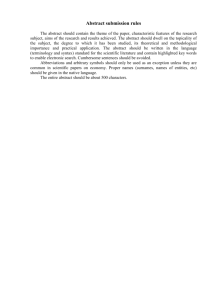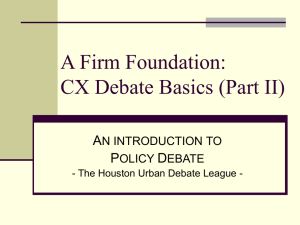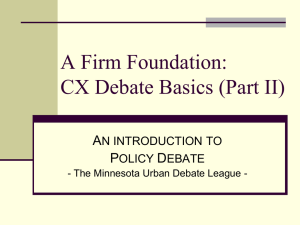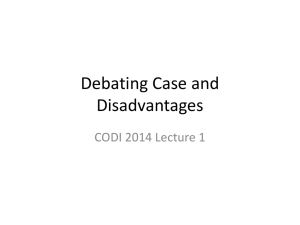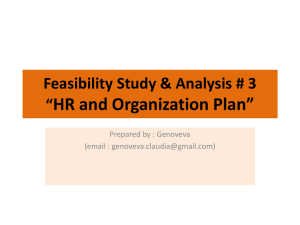Negative Strategy
advertisement
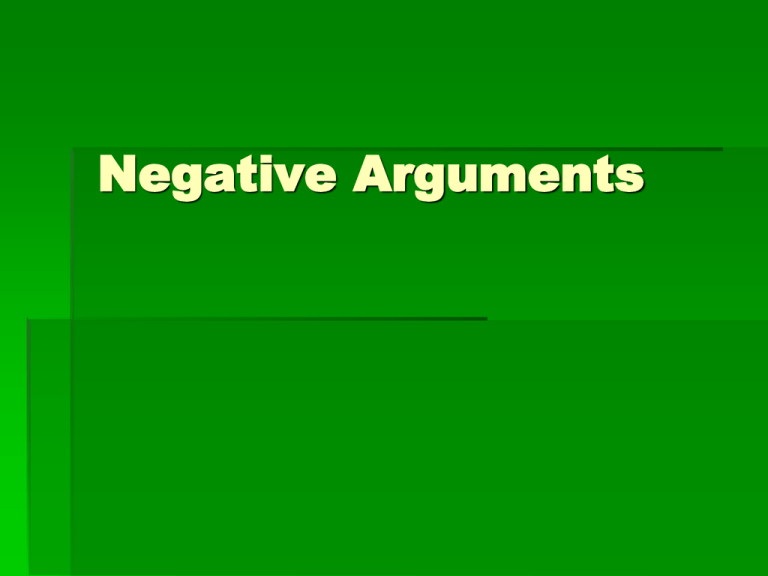
Negative Arguments Topicality One of the stock issues Attack on the Affirmative Plan, not advantages Does the plan fall within the topic (resolution) that we are here to debate? Voting Issue Structure of Topicality Arguments A. Interpretation B. Violation(s) C. Standards (reasons to prefer) D. Voting Issue 2008-09 Resolution and Topicality Resolved: The United States federal government should substantially increase alternative energy incentives in the United States. Alternative Energy Incentives Topicality: Alternative Energy? What is Alternative Energy? Anything not used in the status quo? most technologies have at least some use in the SQ lack of solvency evidence would destroy these cases Depends on the sector Alternative to Fossil Fuels = Anything that is not coal, petroleum, or natural gas Alternative = Anything that is renewable, such as solar, wind, hydro, etc. Topicality: Alternative Energy and Nuclear Power Should nuclear power be included in alternative energy? Clash within the energy and government literature Contextual definitions will be crucial YES: Not a fossil fuel, does not generate greenhouse gases NO: Not renewable, creates dangerous nuclear waste Topicality – Incentives Definition: Something, such as the fear of punishment or the expectation of reward, that induces action or motivates effort (American Heritage Dictionary) Positive – expectation of reward Or Negative – fear of punishment Is a Prohibition a type of Negative Incentive? Is a Mandate also a type of Negative Incentive? Or Both Positive and Negative Incentive Topicality - Incentives Who is the target of the incentive? Example: Government Procurement programs Example: Mandate that vehicles be Flex Fuel capable. It is a requirement on the automobile companies and dealerships. What happens if they do not meet the requirement? The target might be consumers and gas stations. They need to shift their behavior. Who is the ultimate consumer of the alternative energy? Topicality - Increase Increase = Create. Cannot be pre-existing in Federal Law, must be entirely new Negative would be guaranteed uniqueness for their arguments Affirmative would have much fewer case Increase = Expand Must be pre-existing, Cannot be new Negative would be guaranteed more links and a literature base Affirmative would have many cases but limited by solvency advocates Harms Answers Major Advantage Areas: Climate Change, Economy, Foreign Wars, Environment & Pollution Neg teams need basic general answers to all of these Negative Solvency 1. Incentives will not solve. People will ignore or manipulate 2. Incentives will not solve. Too weak to influence behavior & change the entire energy system of the U.S. Market forces rule 3. Status Quo is Solving. Market, corporations, and consumer choice will solve all 4. Status Quo is Solving. State policies 5. Overshoot. Plan comes too late. We are speed towards a brick wall and the brake are too weak. (contradicts #3 & #4 above) Negative Solvency Plan only affects the United States – Global problems will require global solutions. Ex: Greenhouse Gas Emissions, Peak Oil, etc. Multinational Shift – restrictions here cause corporations and manufacturing to leave the U.S. for other countries to avoid negative incentives Backstopping – decrease in U.S. demand for oil will result in a huge drop in prices. Oil consumption then goes back up. Can be intentional (action by OPEC) or automatic (market forces) Disadvantages Bad results from the plan action. It causes something bad or prevents something that is good. Connected to the plan (or sometimes to the advantage) Needs to have a large overall risk (probability X magnitude) Disads – Typical Structure Uniqueness or Brink Link Internal Link Impact Disadvantages – Main Categories Economic Disadvantages Political Disadvantages Supplier Disadvantages Economic Disads General Economic Growth Specific Sector (ex: trucking, steel) Specific States or Regions (ex: WVA, Northwest) Core Economic Actor (ex: electricity grid) Federal Spending & Deficits Financial Sector - Stock Market, Biz Con, Investor Confidence, Hedge Funds Delayed or Diverted Transition (shift to green econ, etc.) Political Disads - Domestic Politics. Example: Political Capital and the India Nuclear Deal Crucial population Crucial congressional leader or coalition Presidential Election. Ex: Plan helps Bush & McCain Crucial demographic (women, Latinos, Native Americans, etc.) Crucial state or region (West Virginia & coal, Michigan & autos) Congressional Election State Elections, especially California Federalism Political Disads International Soft Power. Action would boost U.S. image abroad Isolationism and Retreat, especially in Middle East. This is functionally “oil dependence good” argument Supplier Disads Oil Saudi Arabia: 8.6 million barrels per day (mbpd) in 2006 Russia: 6.57 Norway: 2.54 Iran: 2.52 Venezuela: 2.20 Nigeria: 2.15 Iraq: 1.43 Algeria, Mexico, Libya, Angola, Caspian Sea Region Supplier Disads Coal & Global Coal Prices Australia South Africa Indonesia Ukraine West Virginia Supplier Disads Natural Gas & Global Natural Gas Prices Russia. 182 billion cubic meters Canada. 102 Norway. 78 Algeria. 63 Iran
